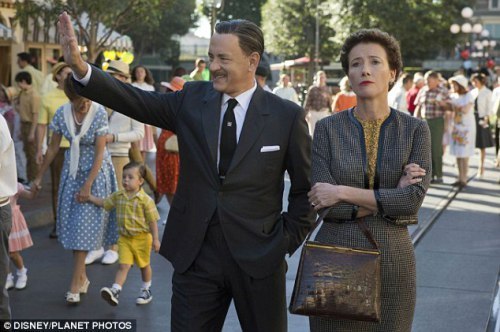Saving Mr. Banks: Stretching, Shrinking, or Sugar-coating Truth
I had quite a jolly time watching SAVING MR. BANKS, though a little way in when my daughter leaned toward me to ask, “Is she still alive?” my whispered “No,” held a big breath of gratitude, certain P.L. Travers would have liked none of this. There’s rarely a happy meeting ground between lovers of the series of MARY POPPINS books first published in 1934 and the 1964 Disney movie starring Julie Andrews and Dick Van Dyke, and this movie may only escalate the tension.
As a writer, I’d like to whole-heartedly take the side of P.L. Travers, who was born named Helen Goff, and her books, charmingly illustrated by Mary Shepard. But then there’s the heart-tugging “Feed the Birds” and “Let’s Go Fly a Kite” written by the Sherman brothers, the singing of Julie Andrews, the dancing of Dick Van Dyke, and what can I say? I’m smitten. Disney did play freely with the first novel, which was written in chapters with beginnings and ends, good for bedtime, like other British classics of the period, including WINNIE-THE-POOH , PETER PAN, and THE WIND IN THE WILLOWS. Disney needed to shape the episodes into an arc, and in conjunction with not wanting to perplex Americans in the early 1960s with the concept of nannies, created a reason for Mary Poppins to come and go, though no reason is given in the book, and is part of its point that life is random. A movie needs to rise and fall, and while I’m uneasy favoring a film over a book, my feelings on this one are like that of WIZARD OF OZ, in which the MGM creators pulled forward the theme of “There’s no place like home” and edited out some of the book’s wayward adventures.
Still, watching SAVING MR. BANKS I was somewhat troubled to see P.L. Travers depicted as a rather nit-picky diva, needing a bit of saving by Walt Disney, who’s shown not just as a creative businessperson but steps in as psychoanalyst. “Saving Mr. Banks, but Throwing P.L. Travers Under the Bus” by Jerry Griswold made me nod in many places. It’s good to hear that the author was nice, deep-thinking and well-liked, more so than the woman played by Emma Thomas in the movie, who’s rude and she sniffs, which may not have been primary traits of P.L. Travers, but do distinguish Mary Poppins as we know her in the book. I told Emily I expected P.L. Travers was surely kinder. But as I read about her last night, hoping for confirmation, I could see that Disney might have given P.L. Travers some breaks. When I reported some faults to Emily, she said, “Sorry, Mom.” There were those tapes that P.L. Travers insisted upon being made at the Disney studios, and prickly remarks were recorded. Good and bad manners may depend upon context, and it seems that while sentimental and greedy Americans may have gotten the bulk of her ire, they weren’t alone. Jerry Griswold found her delightful, but then he is an admiring children’s literature professor who crossed the ocean to interview her for THE PARIS REVIEW. I would have liked to see P.L. Travers shown as slightly more complex, but in SAVING MR. BANKS, she may have been given a fair hand.
Her life was shaped to create a story arc that includes flashbacks to her childhood in the Australia outback, and is based on facts such as her father, whose first name was Travers, had been an alcoholic who had trouble keeping jobs in banks. While Walt Disney gets the insightful lines, he’s masterfully played by Tom Hanks, who shows flashes of tamed temper and the plaster behind some smiles. His secretaries seem to have a heaviness in their smiles and shoulders, too, and their varying stiffness and haste show they deal with a man who respects childhood, but is not all about merry-go-round rides. I loved the roles of the scriptwriter and the Sherman brothers as lyricist and composer, beautifully played by B.J. Novak (Ryan in The Office) and Jason Schwartz. I read that they spoke at some length with Richard Sherman as well as people who knew both brothers to understand the differences between them as well as what made them a great creative team. Caitlin Flanagan’s interesting New Yorker article, ”Becoming Mary Poppins,” quotes Richard Sherman and makes it clear how much the brothers’ work shaped the narrative arc of the musical.
A movie is not a book and it’s certainly not a life. Is SAVING MR. BANKS a trusty reflection of a British author in Hollywood? A lot is left out, of course. Some things are stretched, some shrunken, and there’s sugar where it might not be expected. Maybe it’s best not to compare the movie to a life, but to just enjoy and be touched, as I was. What it shows is that art and life are complex. Childhood, in all its sweetness and darkness, stays with us. Creative people find creative ways to move on, while circling back to days when we learned about love.







